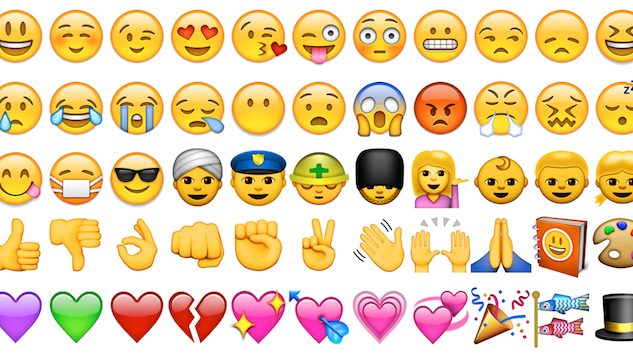The Discursive Limits of Emojis and Memes
Photo courtesy of Getty
The other day, I was speaking to a friend about her New Year’s Resolution. Her resolution was to approach word choice more carefully and to avoid using boilerplate phrases. Rather than responding to a friend’s anecdote with a customary “that’s crazy” or “that’s ridiculous,” she is making a conscious effort to find more particularized, perhaps intimate, ways of engaging in dialogue and observation.
I thought that was brilliant. Her resolution stands to benefit not only her life, but also the lives of people around her. To dedicate oneself to reformed usage may, at first blush, sound like a small or trivial task. But it’s not. Now more than ever, in a social environment constituted by bottomless internet echo-chambers and mutant buzzwords, finding our own way with words is one of the central tasks of the thinking being—and it’s fast becoming one of the most difficult.
Timothy Snyder, a history professor at Yale, touched on this idea recently. His article provided a twenty point guide to defending democracy under a Trump presidency, and his sixth point addressed language. “Avoid pronouncing the phrases everyone else does,” Snyder said. “Think up your own way of speaking, even if only to convey that thing you think everyone is saying.”
In political discourse, this advice is priceless. Take, for example, the phrase “fake news.” In a number of articles, Glenn Greenwald has argued that some of the most overexcited opponents of “fake news” have ended up proliferating false information themselves. For Splice Today, I also warned against the dangerousness of the “fake news” narrative. When it became the central theme of Trump’s first press conference as president-elect, the phrase became fully unintelligible as anything but a coarse political insult. Progressives who first began propagating “fake news” as a political weapon against the right wing should be humiliated by Trump’s appropriation of that weapon, and the left should remember how careful it needs to be, in both speech and thought, to avoid resorting to sloppy concepts.
One of the pervasive problems of modern politics is the mass communication of rigorously complex subjects by recourse to simplified, ear-worm terminology. “Black Lives Matter” is a brilliant and crucial political phrase, and it’s one that I hope does not go away, but how disappointing it was when counter-slogans like “All Lives Matter” or “Blue Lives Matter” took root. The heartbreaking political reality of racialized police violence dissolved into a Wittgensteinian language game. Similarly, it lately seems more important whether one is a feminist or is not a feminist, as though those were ontological categories, rather than the specifics of one’s views on material issues like pay equality, rape culture, reproductive freedom, or gender identity.
On a more quotidian level, consider one of the newest and most pleasurable ways to communicate: emojis. Circa 2010, emojis were incorporated into the Unicode Standard, and since then they’ve become an unavoidable staple of social communication. An emoji was the 2015 Oxford Dictionaries word of the year, and by now we can barely send a text message without including one.
Emojis are a joy. They enhance mobile conversation, and they’re incredibly fun. But there’s a dark side too, and that is the extent to which emojis represent a crude derivative of authentic intersubjective communication, a reification of human emotion itself. Emojis are a determinate toolbox of static, preset emotional states, ones that have been pre-screened for scalability and sold to us by corporate culture. The rapid entrenchment of emojis reflects a disturbing trend in the standardization and conditioning of human experience, which is precisely the mindset most amiable to fascism.
The fundamental problem with emojis appears on Emojipedia’s FAQ page. The frequently asked question is posed: “Can I create my own emoji?” The curt answer is exemplary: “This is not possible.”
Personally, I’ve grown bitterly offended by the tears-of-laughter emoji. The tears-of-laughter emoji has emerged as the most overused and abused of all emojis, and by the time of this writing it has grown completely meaningless. Sensing that some emojis have already become hollow, we now send blurts of identical emojis many times in a row for crude emphasis, but that only hastens the demise of meaning. The moment one recognizes the emoji as a dead, disembodied signifier, a cheap stand-in for genuine human feeling, is a truly depressing moment—because we’ve already come to depend on them for expression.
At some point, one wonders: is that tears-of-laughter emoji laughing for me, on my behalf, so that I don’t have to be bothered with laughing myself? Consider Robert Pfaller’s notion of interpassivity. Emojis carry out the feeling for us. Perhaps I send my loved ones smooching smileys and multicolored hearts as a way to avoid speaking out loud a sequence of words that somehow, throughout thousands of years of human speech, still hasn’t lost its terrifying potency. We still cannot take the words “I love you” lightly, and there are vital human reasons for that. But we can fire off a heart emoji without a second thought.
There are a grand total of 1,851 emojis, including skin tones and modifying sequences. Meanwhile, the Oxford English Dictionary houses over 170,000 words. The diversity and number of signifiers is part of what I’m getting at, but ultimately the point is not about numbers. The problem I’m attempting to identify—that emojis are an externally preset, interpassive structure we detrimentally submit and conform to—is native to language itself.
-

-

-

-

-

-

-

-

-

-

-

-

-

-

-

-

-

-

-

-

-

-

-

-

-

-

-

-

-

-

-

-

-

-

-

-

-

-

-

-








































